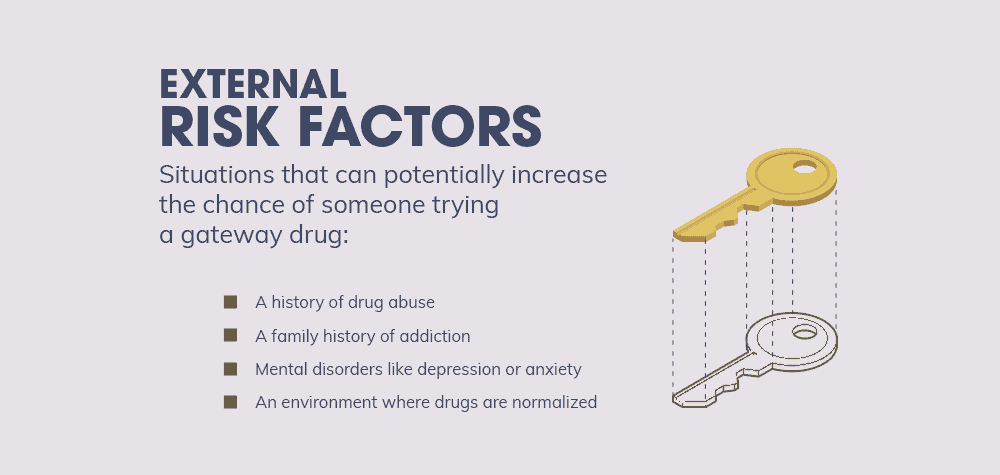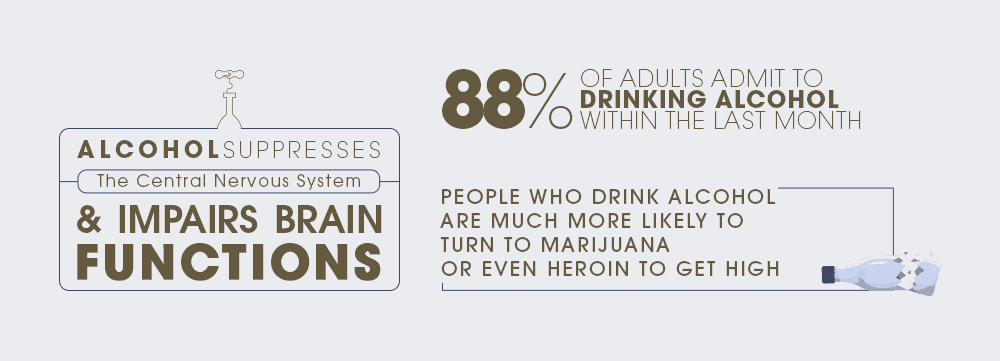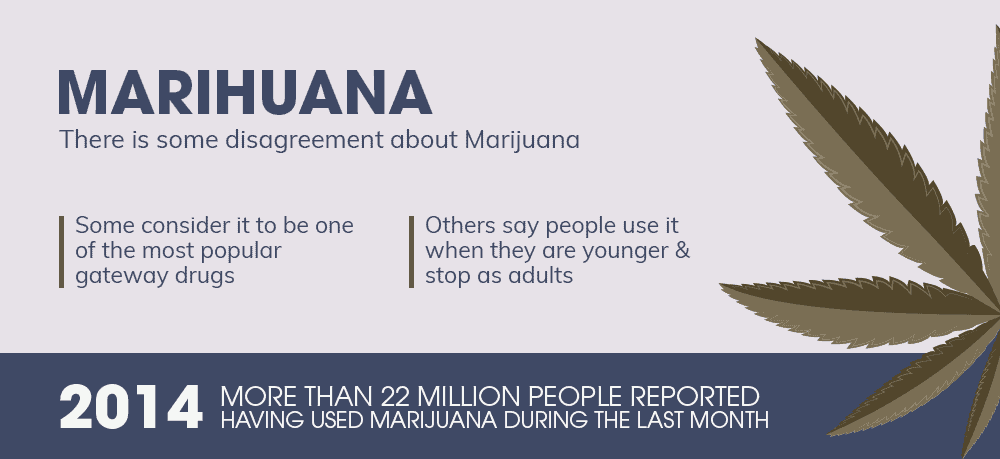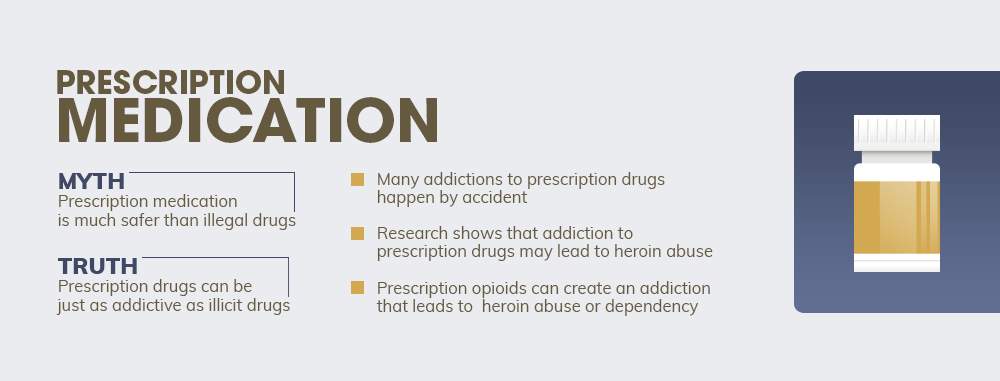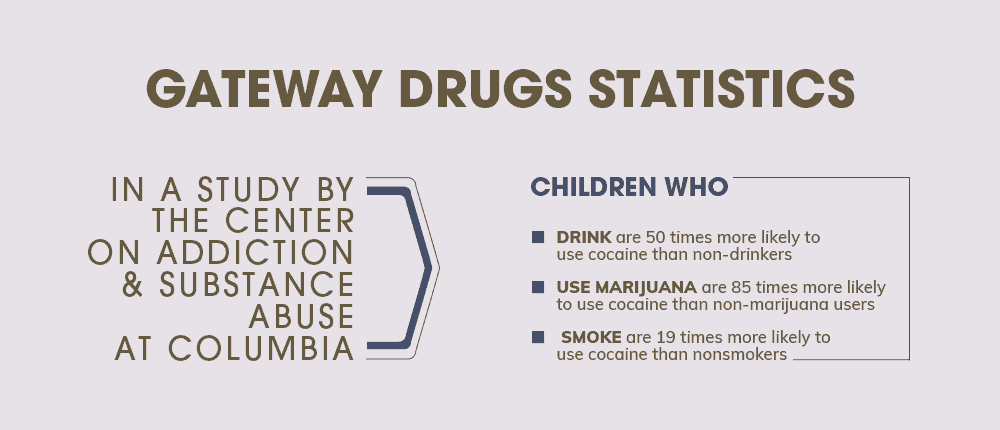The concept of a gateway drug is not new. Most people have heard of the idea but may not know which substances qualify as gateway drugs. It is important for everyone to be wary of gateway drugs. Part of this means understanding the risk factors of addiction and the slow progression toward physical dependence. This brief guide addresses three of the most common gateway drugs that anyone should be wary of:
- Alcohol
- Marijuana
- Prescription medication.
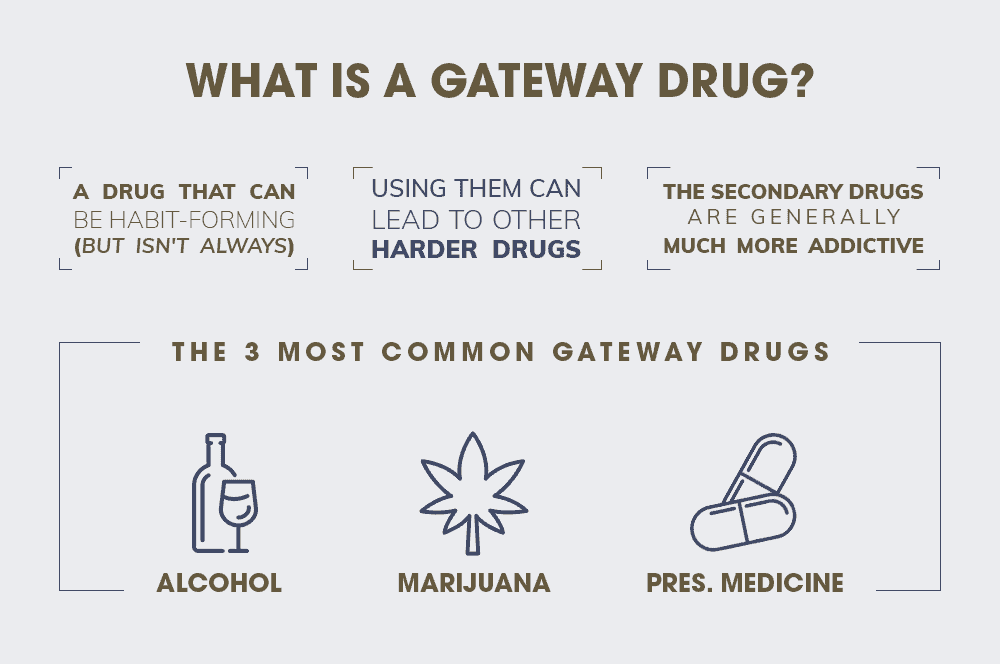
“We treat addiction and provide family therapy. Many health insurance plans accepted. Take a look at our program.”
There is a difference between correlation and causation. The use of these substances leading to addiction has more to do with other risk factors. For many, it is about the dangers of the substance. To get to the bottom of these common gateway drugs to be wary of, we will discuss both factors here. Maybe we need to start with a better understanding of what using gateway drugs actually means. Consider this insight from an academic study on the gateway theory: “The concept of ‘gateway hypothesis’ has been studied since the 1970s as the theory suggests that an adolescent’s early experimentation with alcohol or tobacco or cannabis escalates to more addictive illicit drugs later in adulthood Although the evidence suggests that substance use dependence may also occur with the initial drug experimentation of commonly available legal substances, continual use over time may increase the likelihood of developing risks for substance use disorders and other substance-related illnesses.” ~ Stephen Nikansah-Amankraa & Mark Mineliib The authors are saying that these three substances may lead to addiction. Long-term use of alcohol, marijuana or prescription opioids is directly associated with substance abuse. This is particularly true when substance use begins at an earlier age. Before jumping into how alcohol, marijuana and prescription opioids work as gateway drugs, let’s first cover the risk factors for addiction that come into play.
Understanding the Risk Factors for Addiction
The gateway drug hypothesis does not say that using marijuana, alcohol or prescription drugs automatically leads to addiction or heavy drug use. So there must be something else at play. This ‘something else’ is the risk factors we mentioned above. Some of the most commonly identified risk factors include:
- An environment where drugs are normalized or accepted
- A family history of addiction
- A history of drug abuse
- Mental disorders (such as depression, anxiety or bipolar disorder)
- A social life with frequent drug use
Of course, one of the biggest risk factors for addiction is the age when an individual starts using drugs or drinking alcohol. Check out this excerpt from a Washington Post article that calls alcohol the most dangerous, legal gateway drug: “The question of which drugs kids start with is a lot less important than the question of how early they start using. Overall, early onset substance initiation, whether that is alcohol, tobacco, or other drugs, exerts a powerful influence over future health risk behaviors. The earlier kids started using alcohol, the more likely they were to go on to try other drugs. Kids who had their first drink in 6th or 7th grade went on to try an average nearly two illicit substances later. By contrast, kids who waited until 12th grade to drink had only tried an average of 0.4 substances.” ~ Christopher Ingraham, The Washington Post
“Get the help you need today. We offer outpatient assistance, so you can maintain your work, family, and life commitments while getting the help you deserve!”
Gateway drugs combine with these external risk factors. The result is an environment that fosters drug dependence and sometimes even addiction. We highlight alcohol, prescription opioids and marijuana as the most common gateway drugs. This is to show just how dangerous some substances can be. The info presented here shows that legal substances can pose a major risk of addiction. Sometimes it can lead to the use of harder, more dangerous drugs. It’s important to understand how these substances interact with the risk factors above. Overall, it reflects the dangerous reality of gateway drugs.
#1: Alcohol
Here’s a claim that may be shocking to you: alcohol can be just as addictive and dangerous as any illicit substance. When people think about addiction, they usually think of drugs like prescription opioids or cocaine. Learning about addiction is typically limited to illicit drugs – rather than legal substances like alcohol. But the reality is alcohol can be as addictive as any other drug. One study on the gateway drug phenomenon found unequivocally that alcohol represented the reality of a gateway drug. It led to the use of marijuana, tobacco and other illicit substances. The study from the Journal of Scholastic Health found that young people who drank were more likely to use drugs. The numbers are striking. High school seniors who used alcohol were 16 times more likely to use marijuana and other narcotics. “Alcohol should receive primary attention in school-based substance abuse prevention programming, as the use of other substances could be impacted by delaying or preventing alcohol use. Therefore, it seems prudent for school and public health officials to focus prevention efforts, policies, and monies, on addressing adolescent alcohol use.”~ Adam Barry & T. Kirby, Journal of Scholastic Health The concludes by confirming the gateway hypothesis. “But it follows progression from licit substances, specifically alcohol, and moves on to illicit substances,” the authors write. The study also highlights an important point that we made above. The earlier a young adult starts using alcohol, the more likely they are to abuse other substances. There’s a reason this study was focused on students and young adults. It showed that the earlier someone starts using a gateway drug like alcohol, the bigger the chance that hard drugs will have an influence later on in life. Alcohol is inherently addictive, pure and simple. It may make people feel good for awhile. But its effect on the reward center of the brain means that people can become dependent on its effects. Combine this property with the risk factors identified above and you can very easily have a toxic situation. It can easily lead to additional substance abuse. Recognizing alcohol as a gateway drug shows the substance for what it really is. In reality, alcohol is a depressant drug that reduces the ability to think rationally and make good judgment calls. These undesired effects of alcohol only worsen when substance abuse continues over time.
#2: Marijuana
Marijuana is one of the more contentious substances in the United States right now. Some people hold that it is completely harmless, while others continue to point to its dangers – particularly for young people. On one hand, advocates contend that the drug should be regulated like alcohol or tobacco. On the other, marijuana can lead even so-called casual drug users to use other, more dangerous drugs. We don’t want to jump into this contentious debate, since there is evidence on both sides. But we do want to point out that marijuana is not a good idea for those who are already prone to addiction and drug abuse. In this way, it can act as a gateway drug. The National Institute on Drug Abuse notes that some research shows how marijuana precedes the use of other substances. It can also lead to the development of addiction. But the guide also points out that other factors (like one’s social environment) have a big role in the risk of drug abuse. We’ll touch on that more below. “Marijuana use is positively correlated with alcohol use and cigarette use, as well as illegal drugs like cocaine and methamphetamine. This does not mean that everyone who uses marijuana will transition to using heroin or other drugs, but it does mean that people who use marijuana also consume more, not less, legal and illegal drugs than do people who do not use marijuana. People who are addicted to marijuana are three times more likely to be addicted to heroin.” ~ Robert L. Dupont, former director of the National Institute on Drug Abuse, writing for the New York Times Let’s clarify: using marijuana does not automatically mean you will use more or harder drugs. But the statistics show that someone who uses marijuana is likely to use other substances as well. There has to be some cause and effect there. There are a few ways this takes shape:
- People in an environment of drug abuse may use marijuana more often.
- Being surrounded by heavy drug use at a young age may open the opportunity for other forms of drugs earlier on in life.
- Accepting the ‘casual’ use of marijuana may change one’s attitudes about harder, more dangerous drugs.
Douglas Quenqua highlights just how much of a role risk factors play in predicting the impact of gateway drugs. “Today, health advocates tend to rally around a concept known as common liability theory,” writes Quenqua. The concept “states that certain people, by virtue of biology, environment or both, are simply more likely than others to become addicted to drugs.” In other words, whether marijuana is dangerous or not depends highly on whether you are already predisposed to addiction or substance abuse.
#3: Prescription Medication
The idea that prescription medication is safer than illegal drugs is a myth. If you’re not careful, Oxycontin and Adderall can be just as dangerous as cocaine or heroin. These drugs are often built on the same elements, which is what makes them addictive in the first place. In the last two decades, the prevalence of prescription stimulants and opioids has skyrocketed. The end result is the most severe drug addiction epidemic in US history. According to the National Institute on Drug Abuse, prescription and over-the-counter drugs are the most commonly abused substances by Americans after alcohol and marijuana. “In the late 1990s, pharmaceutical companies reassured the medical community that patients would not become addicted to prescription opioid pain relievers, and healthcare providers began to prescribe them at greater rates. This subsequently led to widespread diversion and misuse of these medications before it became clear that these medications could indeed be highly addictive.” ~ The National Institute on Drug Abuse
“We treat both addiction and co-occurring disorders and accept many health insurance plans. Take a look at our outpatient program today!”
Prescription opioids are a gateway drug in the purest sense of the phrase. When opioid medications are taken outside the strict parameters of a prescription, they can create physical dependence on their effects in a matter of weeks. Heroin has many of the same properties of prescription opioids. Since it is more readily available, people often turn to heroin after first becoming hooked on prescription medication. In a phrase, prescription drugs can lead to the need for other, more dangerous opioids.
Getting Help for Addiction to a Gateway Drug
Whether you think you have a problem with drinking or have become dependent on prescription opioids, you are not without options. Ashwood Recovery at Northpoint offers outpatient treatment for all kinds of addictions. Our mission is to provide the same quality of care we would wish for our own families and loved ones. We are dedicated to helping families and individuals in crisis. This includes those suffering from addiction or other mental health disorders. Choosing Ashwood Recovery programs will give you freedom. We can help you address the dependence you have developed on a gateway drug. If you’re not sure where to begin, you can start by using the resources we provide online:
- Our blog covers everything from understanding why heroin is so addictive to what it means to have an addictive personality.
- Read more about our Intensive Outpatient Program. The program is designed for those struggling with addiction to alcohol or drugs.
- Take one of our Addiction Quizzes. Determine if it’s time to seek professional help and if these gateway drugs are presenting a problem in your life.
- Visit our Addiction Information resources page. Here you can read more about what addiction to alcohol, marijuana or prescription drugs looks like – and what you can do about it.
Do you have more questions about the dangers of gateway drugs or what it means to get professional help for addiction? We are here to help you find the answers. Do not hesitate to contact us today!
What Did you Think About This Blog?
Give it a Rating!
Full Infographic:



